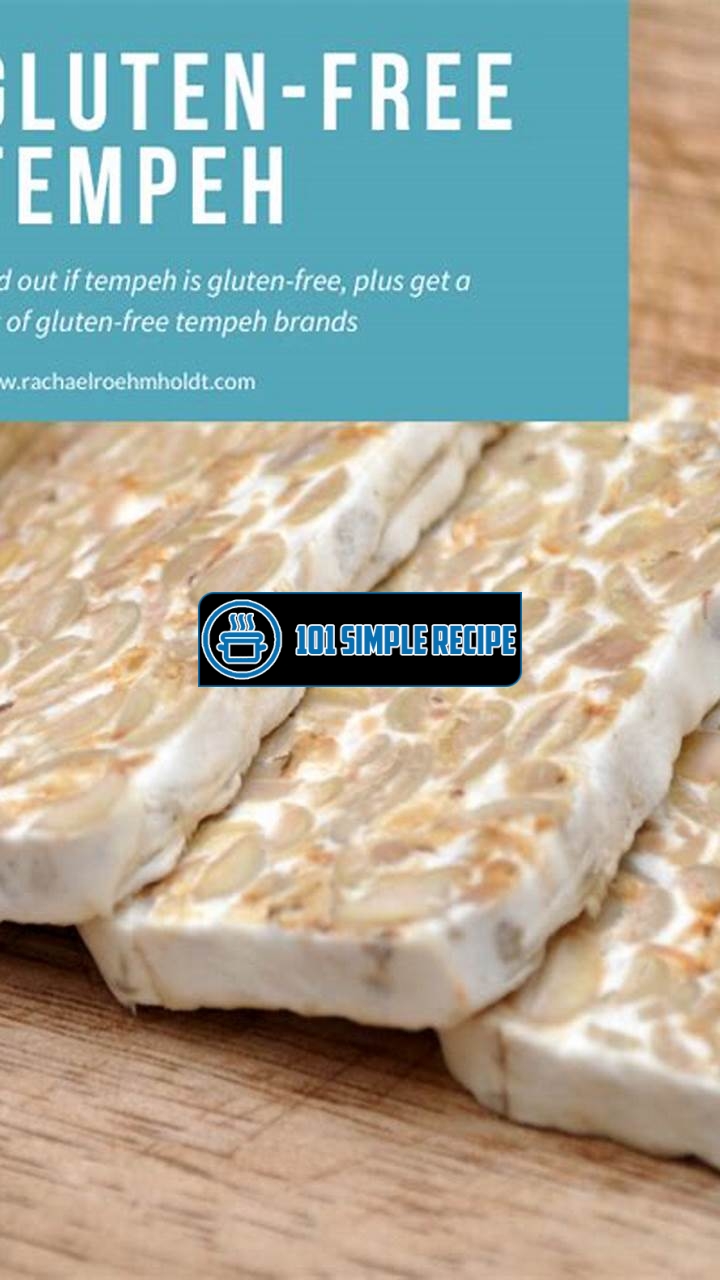Wondering if tempeh is gluten-free? Look no further – we’ve got the answer for you! Tempeh is a popular plant-based protein source that is widely consumed by vegans and vegetarians. Not only is it packed with essential nutrients, but it also offers a unique nutty flavor and a firm texture that adds depth to various dishes. But when it comes to dietary restrictions, particularly gluten sensitivity or celiac disease, understanding whether tempeh is gluten-free becomes essential. So, let’s delve into this topic and find out if tempeh meets the gluten-free criteria.

Understanding Tempeh
Tempeh is a popular plant-based protein source that has gained widespread recognition in recent years. It is a traditional Indonesian food that has been enjoyed for centuries. Tempeh is made from soybeans and is known for its firm texture and nutty flavor. It is a versatile ingredient that can be used in a variety of dishes, making it a favorite among vegans and those looking for meat alternatives.
What is Tempeh?
Tempeh is a fermented food that is made from soybeans. The fermentation process gives it a unique texture and flavor. To make tempeh, soybeans are first soaked, cooked, and then mixed with a culture known as Rhizopus oligosporus. This culture helps break down the soybeans and turn them into a solid cake-like form. The tempeh is then left to ferment for a period of time, usually around 24 to 48 hours, depending on the desired texture and flavor.
Production Process of Tempeh
The production process of tempeh involves several steps to ensure its quality and taste. First, soybeans are soaked in water for several hours to soften them. Once softened, the soybeans are cooked until they become tender. After cooking, the outer skin of the soybeans is removed to make them easier to digest.
Next, the cooked soybeans are mixed with the culture Rhizopus oligosporus. This culture helps initiate the fermentation process by breaking down the soybeans and creating a solid cake-like structure. The mixture is then placed in a clean and sterile environment, usually wrapped in a banana leaf or placed in a special perforated container, to allow air circulation.
During the fermentation process, the Rhizopus oligosporus culture transforms the soybeans into tempeh by producing enzymes that break down the proteins and carbohydrates present in the soybeans. This process gives tempeh its unique texture and flavor. The fermentation time can vary depending on the desired taste and texture, but usually ranges from 24 to 48 hours.
Nutritional Content of Tempeh
Tempeh is not only delicious but also packed with nutrients. It is a great source of protein, essential amino acids, and dietary fiber. It is also rich in vitamins and minerals such as iron, calcium, and vitamin B12.
One serving of tempeh, which is about 100 grams, contains approximately 200 calories and provides 20 grams of protein. It is also low in saturated fat and cholesterol, making it a healthy choice for those looking to incorporate more plant-based foods into their diet.
In conclusion, tempeh is a versatile and nutritious plant-based protein source. It is made from fermented soybeans and has a unique texture and flavor. The production process involves soaking, cooking, and fermenting the soybeans with the help of Rhizopus oligosporus culture. Tempeh is not only a delicious addition to meals but also a great source of essential nutrients.
Gluten and Gluten Sensitivity
Get an in-depth understanding of gluten and its impact on individuals with gluten sensitivity.
What is Gluten
Gluten is a type of protein commonly found in grains such as wheat, barley, and rye. It gives dough elasticity and helps it rise during baking. Gluten is made up of two proteins: gliadin and glutenin. While some people can digest gluten without any issues, others may have a sensitivity or intolerance to it.
Important point: Gluten is not naturally present in tempeh, which is made from fermented soybeans. Therefore, tempeh is considered gluten-free.
Gluten Sensitivity and Celiac Disease
Gluten sensitivity, also known as non-celiac gluten sensitivity, refers to a condition where individuals experience adverse reactions to gluten consumption. Unlike celiac disease, which is an autoimmune disorder, gluten sensitivity does not damage the small intestine. However, it can still cause uncomfortable symptoms.
Important point: Celiac disease is an autoimmune disorder triggered by the ingestion of gluten. It affects the small intestine and can lead to long-term complications if not managed properly.
When individuals with celiac disease consume gluten, their immune system reacts by attacking the lining of the small intestine. This immune response damages the villi, small finger-like projections responsible for nutrient absorption. Over time, this damage can lead to malnutrition and other health complications.
Common Symptoms of Gluten Sensitivity
Gluten sensitivity can manifest in various ways, and the symptoms can vary from person to person. Some common symptoms include:
- Abdominal pain and bloating
- Diarrhea or constipation
- Nausea and vomiting
- Headaches
- Fatigue
- Joint and muscle pain
- Brain fog and difficulty concentrating
- Skin problems, such as eczema or rashes
Important point: If you suspect you have gluten sensitivity, it is important to consult with a healthcare professional to receive a proper diagnosis. They can help you navigate your diet and manage your symptoms effectively.
It’s worth noting that tempeh, a plant-based protein source, does not contain gluten. As a result, it is a suitable option for individuals with gluten sensitivity or celiac disease. However, it is always advisable to check product labels to ensure there are no cross-contamination risks during manufacturing.
In conclusion, tempeh is a gluten-free food option that can be enjoyed by individuals with gluten sensitivity and celiac disease. Its nutritional profile and versatility make it a valuable addition to a varied and balanced diet.
Is Tempeh Gluten-Free?
Discover whether tempeh is a suitable option for a gluten-free diet.
Gluten-containing Foods to Avoid
When following a gluten-free diet, it’s important to be aware of the foods that contain gluten. Gluten is a protein found in wheat, barley, rye, and triticale. This means that foods like bread, pasta, cereals, and pastries typically contain gluten. Other commonly consumed gluten-containing foods include beer, certain sauces, soups, and processed meats.
It’s crucial to carefully read food labels and identify any gluten-containing ingredients. Some words to look out for include wheat, barley, rye, malt, and brewer’s yeast. By avoiding these foods and ingredients, individuals adhering to a gluten-free diet can maintain a healthy lifestyle and manage their gluten intolerance or celiac disease.
Cross-Contamination and Tempeh
When considering tempeh as part of a gluten-free diet, it’s important to think about the potential for cross-contamination. Cross-contamination occurs when gluten-free foods come into contact with gluten-containing ingredients during preparation or cooking.
Tempeh itself is made from fermented soybeans and does not naturally contain gluten. However, cross-contamination can occur during manufacturing processes or in restaurants where shared cooking surfaces or utensils are used. To ensure tempeh remains gluten-free, it’s essential to purchase products from reliable sources that follow stringent manufacturing and labeling practices.
It’s also advisable to check if the packaging includes a gluten-free label or certification. This can provide additional assurance that the tempeh has undergone testing and meets the necessary standards to be classified as gluten-free.
Labelling and Certification of Gluten-Free Tempeh
When shopping for tempeh, it’s beneficial to look for products that are labeled as gluten-free. This label indicates that the manufacturer has taken steps to ensure the product is safe for individuals who follow a gluten-free diet.
Some manufacturers voluntarily submit their products for third-party certification. These certifications involve rigorous testing to verify that the tempeh contains less than the allowable amount of gluten (usually 20 parts per million or ppm). This provides consumers with added confidence in the gluten-free status of the product.
While the nutritional value of tempeh makes it an appealing protein source for those following a gluten-free diet, it’s crucial to remain vigilant and informed. Always check the labels for gluten-free certifications, and if dining out, be sure to inquire about any potential cross-contamination risks.
Ultimately, with proper care and attention, tempeh can be a delicious and safe addition to a gluten-free lifestyle.
Benefits of Gluten-Free Tempeh
Gluten-free tempeh is becoming increasingly popular among health-conscious individuals. Not only does it offer a delicious and nutritious alternative for those with gluten sensitivities, but it also provides several benefits that can improve your overall well-being. Here are some advantages of incorporating gluten-free tempeh into your diet:
1. High Protein Content
Gluten-free tempeh is a fantastic source of protein, making it an excellent choice for vegans, vegetarians, and individuals looking to enhance their protein intake. One serving of tempeh contains around 15 grams of protein, which is equivalent to the protein content found in a 2-ounce serving of beef! Protein is essential for muscle growth and repair, as well as for maintaining a healthy immune system. By including gluten-free tempeh in your meals, you can easily meet your daily protein requirements.
2. Improved Digestion
Tempeh is fermented, which means it contains beneficial probiotics. These probiotics help promote a healthy digestive system by supporting the growth of good bacteria in your gut. This can result in improved digestion and a reduced risk of digestive issues such as bloating, constipation, and diarrhea. Moreover, the fermentation process breaks down the hard-to-digest components found in soybeans, making it easier for your body to absorb the nutrients and digest tempeh compared to other soy products.
3. Increased Nutrient Absorption
In addition to aiding digestion, the fermentation process also enhances nutrient absorption. The fermentation of soybeans in tempeh increases the bioavailability of nutrients like iron, calcium, and zinc, enabling your body to absorb and utilize them more effectively. This means that by consuming gluten-free tempeh, you can maximize the nutritional benefits of the foods you eat!
4. Healthier Blood Sugar Levels and Weight Management
One lesser-known benefit of gluten-free tempeh is its potential to help maintain healthy blood sugar levels and support weight management. Tempeh is a low-glycemic food, which means it does not cause a rapid spike in blood sugar levels after consumption. This can be especially beneficial for individuals with diabetes or those looking to regulate their blood sugar levels. Additionally, the high protein and fiber content of tempeh can contribute to feelings of fullness, reducing the likelihood of overeating and aiding in weight management.
Overall, gluten-free tempeh is a versatile and nutritious food that can bring various benefits to your diet and overall health. Whether you are looking to increase your protein intake, improve digestion, enhance nutrient absorption, or support blood sugar control, tempeh can be an excellent addition to your meals. So why not give it a try and enjoy the many advantages it has to offer? ✨
How to Incorporate Tempeh into a Gluten-Free Diet
Discover creative and delicious ways to enjoy tempeh while following a gluten-free lifestyle.
Tempeh in Salads and Sandwiches
Tempeh can be a fantastic addition to salads and sandwiches for those following a gluten-free diet. Its firm yet chewy texture adds a delightful contrast to crisp greens and bread alternatives. Try marinating thin slices of tempeh in a mixture of gluten-free soy sauce, a squeeze of lemon juice, and your favorite herbs and spices. Then, pan-fry the marinated tempeh until golden brown and place it on top of a colorful salad or slip it into a gluten-free sandwich. The tempeh adds a rich, savory flavor that pairs perfectly with fresh veggies and gluten-free bread.
Another way to enjoy tempeh in salads is by crumbling it over a bed of mixed greens. By crumbling the tempeh, it takes on a texture similar to bacon bits, which adds a satisfying crunch to your salad. You can also toss the crumbled tempeh in a gluten-free salad dressing of your choice for added flavor.
Tempeh as a Meat Substitute
If you’re following a gluten-free diet but still crave the taste and texture of meat, tempeh can be a fantastic meat substitute. Tempeh is highly versatile and can be used in various dishes that traditionally call for meat. One popular option is to marinate thick slabs of tempeh in a mixture of gluten-free barbecue sauce, garlic, and spices. Then, grill or bake the marinated tempeh until it is slightly charred and crispy on the outside.
Another creative way to use tempeh as a meat substitute is to crumble it and use it in place of ground meat in dishes such as tacos, chili, or pasta sauce. Simply crumble the tempeh into small pieces and sauté it with your favorite seasonings and vegetables. The tempeh absorbs the flavors of the dish, providing a hearty and satisfying alternative to traditional meat.
Tempeh in Stir-Fries and Buddha Bowls
Stir-fries and Buddha bowls are both popular dishes that can easily be made gluten-free with the addition of tempeh. Tempeh pairs well with a variety of vegetables and sauces, making it a versatile ingredient in these Asian-inspired dishes.
To incorporate tempeh into a stir-fry, start by sautéing your favorite vegetables in a gluten-free sauce. Once the vegetables are cooked to your liking, add sliced tempeh to the pan and stir-fry until it is heated through. The tempeh will absorb the flavors of the sauce and vegetables, creating a delicious and satisfying dish.
Buddha bowls, on the other hand, are a combination of cooked and raw ingredients arranged in a bowl. They typically feature a grain, protein, and vegetables. Tempeh can be marinated and roasted or pan-fried to add as the protein component of your Buddha bowl. Its meaty texture and umami flavor make it a great addition to these nutrient-packed bowls.
With its versatile nature and delicious flavor, tempeh can be easily incorporated into a gluten-free diet. Whether you enjoy it in salads, as a meat substitute, or in stir-fries and Buddha bowls, tempeh offers a healthy and satisfying option for those following a gluten-free lifestyle.
Frequently Asked Questions
Thank you for taking the time to read our article on whether tempeh is gluten-free. We hope you found the information helpful and informative. If you have any more questions or need further assistance, please don’t hesitate to reach out to us. We are always here to help!
| No. | Questions | Answers |
|---|---|---|
| 1. | Is tempeh gluten-free? | Yes, tempeh is gluten-free. It is made from fermented soybeans and does not contain any wheat or gluten-containing ingredients. However, it is always important to check the packaging and ensure that it is certified gluten-free, as cross-contamination can occur during processing. |
| 2. | What is tempeh made of? | Tempeh is made of fermented soybeans that are bound together into a cake-like form. It is a traditional Indonesian food that has gained popularity worldwide for its nutty flavor, firm texture, and high protein content. |
| 3. | Is tempeh a good source of protein? | Yes, tempeh is an excellent plant-based source of protein. It contains all the essential amino acids, making it a complete protein. Consuming tempeh as part of a balanced diet can contribute to meeting your daily protein needs. |
| 4. | How can I cook tempeh? | There are various ways to cook tempeh. It can be sliced and stir-fried, grilled, baked, or crumbled into dishes like chili or tacos. Marinating tempeh before cooking can enhance its flavor and make it even more delicious. |
| 5. | Is tempeh suitable for vegetarians and vegans? | Yes, tempeh is a great source of protein for vegetarians and vegans. It is made entirely from plant-based ingredients and does not contain any animal products. It is also a versatile ingredient that can be used in a variety of vegetarian and vegan recipes. |
| 6. | Are there any health benefits of eating tempeh? | Yes, there are several health benefits of eating tempeh. It is a good source of protein, fiber, and various nutrients. It may help improve digestive health, promote bone health, and support heart health. Incorporating tempeh into your diet can be beneficial for overall well-being. |
Thank You for Reading!
We hope you enjoyed learning about whether tempeh is gluten-free. Remember, tempeh is a delicious, versatile, and nutritious food that can be enjoyed by people with gluten intolerances or those looking for plant-based protein options. If you have any more questions or need further information, please visit us again later. Stay healthy and have a fantastic day!





